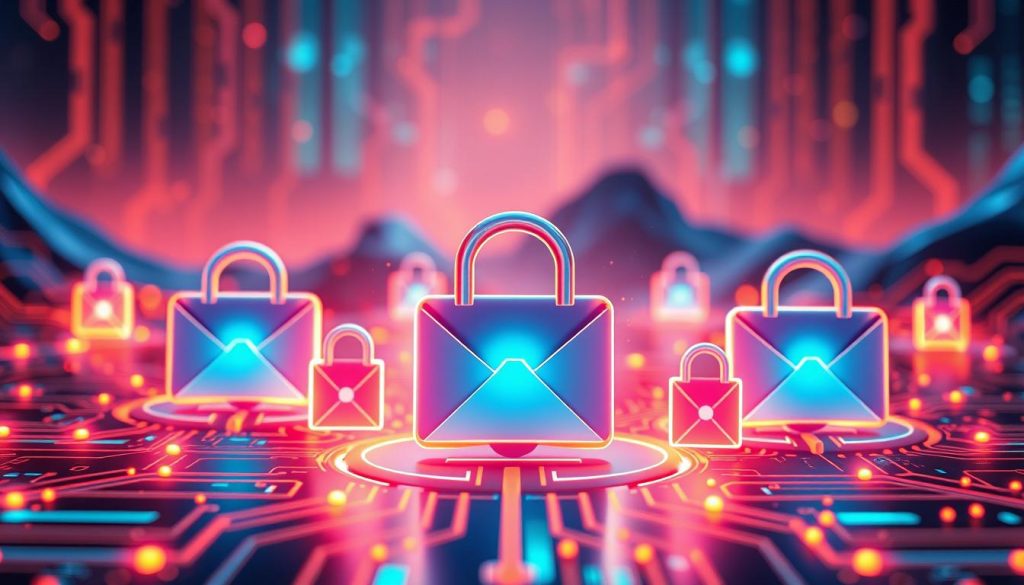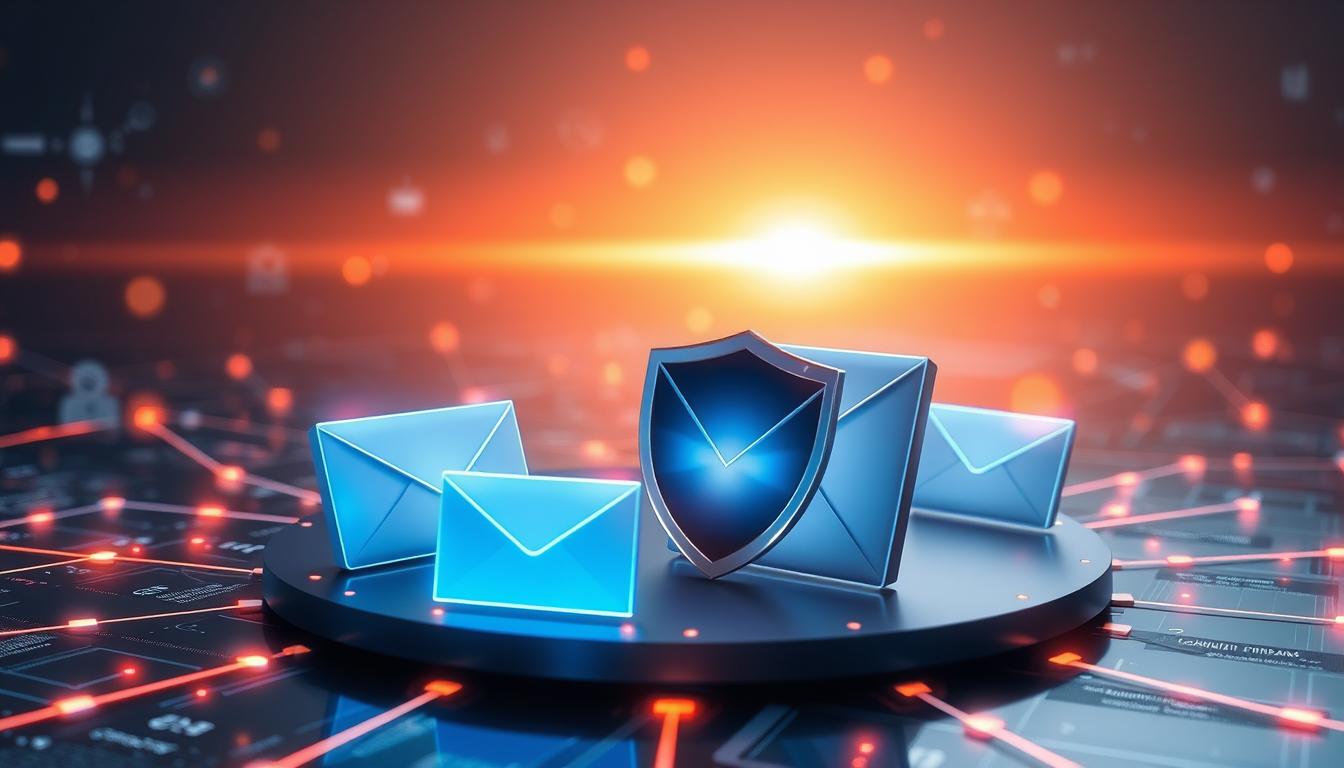The digital world is changing fast, and email security is more important than ever. DMARC (Domain-based Message Authentication, Reporting, and Conformance) is key to keeping emails safe. By 2025, all businesses need to use DMARC to fight off phishing, spoofing, and BEC attacks.
DMARC checks who sends emails, stops fake emails, and keeps your emails safe. Soon, using DMARC will be a must for everyone. It’s what keeps your emails secure and your business safe.
This article will show why DMARC is so important in 2025. We’ll talk about the dangers of email threats, why the law requires it, and how it helps your business. Knowing about DMARC helps your company stay safe in the world of cybersecurity.
Key Takeaways
- DMARC adoption is crucial for safeguarding email infrastructure against growing threats like phishing and business email compromise.
- Regulatory bodies and industry leaders are expected to emphasize the importance of DMARC implementation by 2025.
- DMARC helps organizations verify sender identities, prevent unauthorized domain use, and mitigate the impact of email-borne attacks.
- Implementing DMARC can provide a competitive advantage and deliver tangible business benefits in terms of cost savings and reputational protection.
- Understanding the significance of DMARC is essential for organizations to proactively fortify their email defenses in the evolving cybersecurity landscape.
Understanding DMARC: What It Is and How It Works
In today’s digital world, domain impersonation prevention and strong email authentication are key. They help protect businesses and people from fraud and cyber threats. DMARC is at the center of this fight, changing how we keep our email safe.
The Basics of DMARC
DMARC stands for “Domain-based Message Authentication, Reporting, and Conformance.” It’s built on SPF and DKIM. It helps email receivers check if messages are real, making sure they’re from the right sender.
The Key Components of DMARC
- Authentication: DMARC uses SPF and DKIM to check if an email is from the right domain.
- Reporting: It lets email receivers share reports with domain owners. These reports show how well emails are being sent and received.
- Conformance: Domain owners can choose what to do with emails that don’t pass the check. They can quarantine or reject them.
Benefits of Implementing DMARC
Using DMARC has many advantages for all kinds of organizations:
- It makes emails safer and protects against phishing and domain impersonation.
- It helps make sure real emails get to their recipients without being seen as spam.
- It gives a clear view of email traffic and helps spot and stop unauthorized use of a domain.
- It shows that a company follows email security and data protection rules.
Learning about DMARC and its parts helps organizations protect their email. It keeps their brand safe in the online world.
The Rising Threat of Email Fraud
Email is a key way we communicate today. But, it’s also a big target for hackers. Phishing attacks, email spoofing, and business email compromise are getting worse. It’s important to know about these threats to stay safe.
Current Trends in Email-Based Attacks
Hackers keep finding new ways to trick people. Phishing attacks are getting smarter, where scammers pretend to be someone you trust. They try to get you to give out personal info or install bad software.
Email spoofing is another trick. It makes it look like an email is from someone it’s not. This helps scammers get past security.
Business email compromise (BEC) scams are also big. They trick employees into sending money or data to fake people. It looks like it’s from someone in charge.
Case Studies of Email Fraud Incidents
There are many examples of how bad email scams can be. One big case was when a company lost $50 million. The scammers pretended to be the CEO to get money sent to them.
Another case was a small business that got tricked into giving out W-2 info. This caused a lot of trouble for them. These stories show why we need strong email security.
How DMARC Mitigates These Threats
DMARC is a tool that helps fight phishing attacks, email spoofing, and business email compromise. It checks if emails are really from who they say they are. This helps stop fake emails from getting through.
Using DMARC makes email safer for businesses. It adds a strong defense against email scams.
Regulatory Compliance and DMARC
Email security is now a top concern for all businesses. As data protection rules change, following these rules is more important than ever. DMARC, or Domain-based Message Authentication, Reporting, and Conformance, is key in this area.
Overview of Email Security Regulations
Rules like GDPR and HIPAA set strict data handling standards. They require strong email security to prevent unauthorized access and data breaches.
How DMARC Supports Compliance
DMARC is a protocol that helps meet email security standards and data protection regulations. It authenticates email domains, stopping cybercriminals from spoofing identities for phishing attacks.
Impact of Non-compliance in 2025
Not following compliance requirements can lead to big problems. In 2025, non-compliance could mean huge fines and damage to reputation. Without DMARC or similar security, businesses risk serious issues.
| Regulation | Key Email Security Requirements | How DMARC Supports Compliance |
|---|---|---|
| GDPR | Robust data protection measures, including email security | DMARC helps prevent email spoofing, a common tactic in phishing attacks that can lead to data breaches |
| HIPAA | Secure transmission of protected health information (PHI) via email | DMARC ensures that only authorized entities can send emails on behalf of the organization, reducing the risk of PHI exposure |
As rules keep changing, using email security standards like DMARC is crucial. It helps organizations meet compliance requirements and avoid risks in 2025 and later.
The Business Case for DMARC Adoption
Email fraud is a growing threat, making DMARC (Domain-based Message Authentication, Reporting, and Conformance) more important. Companies need to consider the cost of DMARC against the risks of cyber attacks. They also need to think about the benefits of protecting their brand.
Cost of Email Fraud vs. DMARC Implementation
Email fraud can cost a lot, with each attack costing over $80,000. DMARC, on the other hand, is affordable, costing a few hundred to a few thousand dollars a year. This makes DMARC a smart choice for fighting email fraud.
Competitive Advantage Through DMARC
Using DMARC can give companies a big edge in the market. It shows they care about email security and protecting their brand. This can help them stand out and gain trust from customers and partners.
ROI: Measuring the Benefits of DMARC
| Metric | Potential Benefit |
|---|---|
| Reduced email fraud losses | Savings of up to $80,000 per incident |
| Improved brand reputation | Increased customer trust and loyalty |
| Compliance with regulations | Avoidance of fines and penalties |
| Operational efficiency | Streamlined email security management |
Tracking the benefits of DMARC can show a clear return on investment. This makes a strong case for supporting and growing email security efforts.
DMARC Implementation: A Step-by-Step Guide
Setting up DMARC (Domain-based Message Authentication, Reporting, and Conformance) might look hard. But with a good plan, it’s easy to add this email security tool to your system. Here, we’ll show you how to do it right.
Preparing for DMARC Adoption
First, check your email setup. Look at all domains and subdomains you use for emails. Also, check any third-party email services. Knowing this helps you plan better and avoid problems.
Technical Setup of DMARC
After you know your email setup, it’s time to set up DMARC. You need to update your DNS records. This tells the world how to check if emails are really from you.
- Start with a DMARC policy of “p=none” to watch emails without blocking them.
- Then, make the policy stronger to “p=quarantine” and then “p=reject” as you get more confident.
- Make sure your DMARC records are right by using online tools and watching your emails.
Testing and Monitoring Post-Implementation
DMARC work doesn’t stop after setup. You need to keep watching and adjusting. Look at DMARC reports from email services to find problems. Use this info to make your email security even better.
By following these steps, you can add DMARC to your email system. This makes your emails safer and more reliable.
Aligning DMARC with Your Email Strategy
Adding DMARC to your email security is key. It makes your email system stronger. This way, your email security strategy fits well with other security steps.
How DMARC Fits into Overall Email Security
DMARC is part of a bigger email security strategy. It works with SPF and DKIM to fight off email threats. With DMARC, you can lower the chance of email security problems and make your email safer.
Integrating DMARC with Other Security Protocols
- Match DMARC with SPF and DKIM for a strong security integration in emails.
- Make sure DMARC fits with other security steps like email encryption and anti-phishing tools for a solid security strategy.
- Keep checking and updating DMARC as part of a big cybersecurity awareness plan.
Educating Your Team About DMARC
For DMARC to work well, everyone who uses email needs to know about it. Give them good training and rules. This way, they’ll see how important DMARC is for email safety. Keep teaching them to keep the email security strategy strong and the team alert.
| Key Benefits of Aligning DMARC with Email Security Strategy | Impact |
|---|---|
| Strengthened email infrastructure protection | Less chance of email attacks and more trust in emails |
| Improved overall security integration with other security protocols | Better control and visibility over email security |
| Increased cybersecurity awareness among employees | Everyone helps keep email safe with best practices |
By linking DMARC with your email security strategy, you make your email system stronger. This helps fight off email threats and builds a team that’s aware of cybersecurity.

Common Misconceptions About DMARC
DMARC is key for email security, but many myths and misconceptions exist. These can slow down its adoption, especially for small and medium-sized businesses (SMBs). Let’s clear up some of these DMARC myths and email security misconceptions.
DMARC Is Too Complicated
Many think DMARC is too hard to set up. But, the truth is, it’s now easier than ever. There are many resources and tools to help businesses through the process. With the right help, even SMBs can use DMARC effectively.
DMARC Is Only for Large Organizations
Some believe DMARC is only for big companies. But, DMARC is just as crucial for SMBs. SMBs are often more at risk due to limited budgets and expertise. DMARC can help protect them from email scams and phishing.
DMARC Guarantees Email Security
DMARC is powerful, but it’s not a complete solution for email security. DMARC should be part of a comprehensive email security strategy. This includes training, encryption, and multi-factor authentication. By combining DMARC with other security measures, businesses can improve their email protection.
By tackling these misconceptions, businesses can make better choices about DMARC. They’ll understand its role in enhancing their email security and cybersecurity.
Future-Proofing Your Email Security with DMARC
Looking ahead to 2025, the world of cybersecurity will change a lot. Emerging cybersecurity threats will need a stronger and more active email security plan. DMARC (Domain-based Message Authentication, Reporting, and Conformance) is becoming a key tool to tackle these challenges.
Anticipating Future Threats in 2025
Cybercriminals are always coming up with new ways to attack email systems. In 2025, we’ll see more AI-powered email attacks. These attacks will use artificial intelligence to make phishing and email fraud more widespread. Also, blockchain authentication might bring new risks that hackers will try to exploit.
The Evolving Role of DMARC
- DMARC will be key in fighting these new threats, offering a strong and flexible way to protect against email attacks.
- As email security gets better, DMARC will work with new tech like AI and blockchain. This will make it even better at stopping fraud.
- Companies that use DMARC now will be ready for the future. They can quickly update their defenses against new threats.
Innovations in Email Security Technology
The future of email security will bring in new tech. AI-powered email security solutions will use smart learning to catch and stop phishing attacks fast. Blockchain-based authentication will also help make email safer, adding a new layer of security against fraud.
By using DMARC and keeping up with new email security tech, companies can protect their email systems. They’ll stay ahead of the threats in 2025 and beyond.
Conclusion: Make 2025 the Year for DMARC
Email security is key for businesses in 2025. DMARC adoption helps protect against cyber threats. It’s now crucial to follow strong cybersecurity practices to keep digital trust and operations safe.
Recap of Key Strategic Advantages
DMARC offers many benefits for email protection. It boosts sender reputation, cuts down on email scams, and improves delivery rates. Companies can use advanced email security strategies to protect their digital communication.
Urgent Call to Action
It’s time to act. Businesses need to make DMARC a key part of their cybersecurity plan. By authenticating email domains and stopping breaches, they can keep their reputation and customer trust safe in a complex digital world.
Next Steps for Implementation
Begin your DMARC journey with a detailed email security check. Create a step-by-step plan and train your employees. Get help from cybersecurity experts to make your digital communication secure.
FAQ
What is DMARC and why is it important for email security?
DMARC stands for Domain-based Message Authentication, Reporting & Conformance. It’s a protocol that fights email threats like phishing and spoofing. By checking the sender’s identity, DMARC helps ensure emails are real, making it key to email security in 2025.
How does DMARC work?
DMARC uses SPF and DKIM to secure emails. It has three parts: a policy record, a reporting system, and actions based on that policy. This framework helps keep emails safe.
What are the benefits of implementing DMARC?
DMARC has many benefits. It stops domain impersonation, lowers phishing risks, and boosts email delivery. It also shows your commitment to email security and data protection.
How does DMARC help organizations meet regulatory compliance requirements?
DMARC aids in meeting email security regulations like GDPR and HIPAA. It sets up a strong authentication framework. This shows you’re serious about data protection and cybersecurity.
What are the common misconceptions about DMARC?
Some think DMARC is hard to set up or only for big companies. But, it’s easy with modern tools and helps all sizes. It’s not a complete security solution but a vital part of it.


